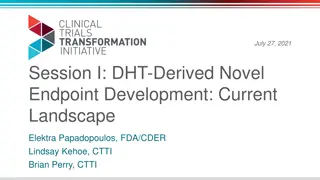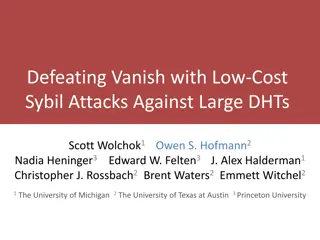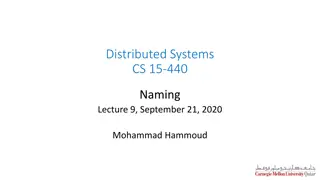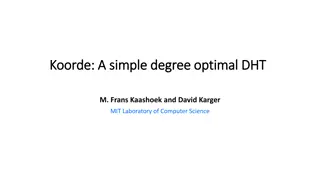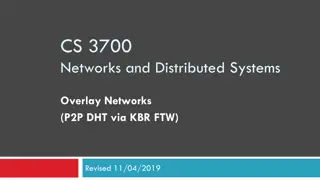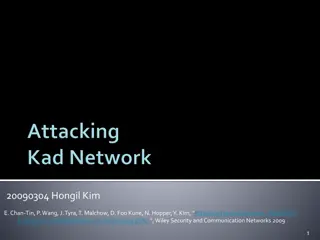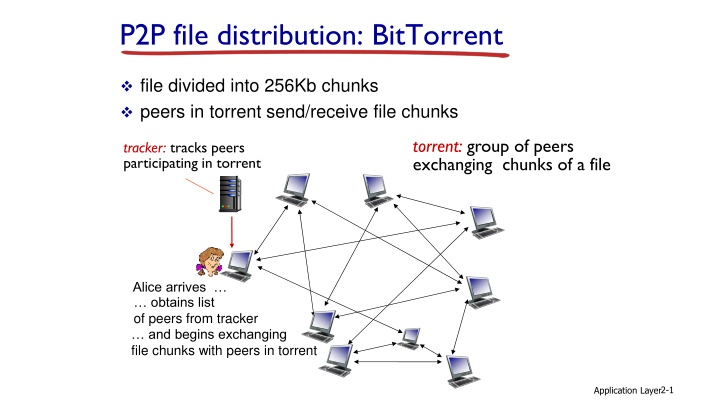
Efficient P2P File Distribution with BitTorrent Protocol
Explore the efficient file distribution process through the BitTorrent protocol, where files are divided into chunks and exchanged among peers in torrents. Learn about peer joining, requesting and sending file chunks, tit-for-tat strategies, and the role of Distributed Hash Table (DHT) in managing peers in a decentralized network.
Uploaded on | 2 Views
Download Presentation

Please find below an Image/Link to download the presentation.
The content on the website is provided AS IS for your information and personal use only. It may not be sold, licensed, or shared on other websites without obtaining consent from the author. If you encounter any issues during the download, it is possible that the publisher has removed the file from their server.
You are allowed to download the files provided on this website for personal or commercial use, subject to the condition that they are used lawfully. All files are the property of their respective owners.
The content on the website is provided AS IS for your information and personal use only. It may not be sold, licensed, or shared on other websites without obtaining consent from the author.
E N D
Presentation Transcript
P2P file distribution: BitTorrent file divided into 256Kb chunks peers in torrent send/receive file chunks torrent: group of peers exchanging chunks of a file tracker: tracks peers participating in torrent Alice arrives obtains list of peers from tracker and begins exchanging file chunks with peers in torrent Application Layer2-1
P2P file distribution: BitTorrent peer joining torrent: has no chunks, but will accumulate them over time from other peers registers with tracker to get list of peers, connects to subset of peers ( neighbors ) while downloading, peer uploads chunks to other peers peer may change peers with whom it exchanges chunks churn: peers may come and go once peer has entire file, it may (selfishly) leave or (altruistically) remain in torrent Application Layer2-2
BitTorrent: requesting, sending file chunks requesting chunks: at any given time, different peers have different subsets of file chunks periodically, Alice asks each peer for list of chunks that they have Alice requests missing chunks from peers, rarest first sending chunks: tit-for-tat Alice sends chunks to those four peers currently sending her chunks at highest rate other peers are choked by Alice (do not receive chunks from her) re-evaluate top 4 every10 secs every 30 secs: randomly select another peer, starts sending chunks optimistically unchoke this peer newly chosen peer may join top 4 Application Layer2-3
BitTorrent: tit-for-tat (1) Alice optimistically unchokes Bob (2) Alice becomes one of Bob s top-four providers; Bob reciprocates (3) Bob becomes one of Alice s top-four providers higher upload rate: find better trading partners, get file faster ! Application Layer2-4
Distributed Hash Table (DHT) Hash table DHT paradigm Circular DHT and overlay networks Peer churn
Simple Database Simple database with(key, value) pairs: key: human name; value: social security # Key John Washington Diana Louise Jones Xiaoming Liu Rakesh Gopal Linda Cohen . Lisa Kobayashi Value 132-54-3570 761-55-3791 385-41-0902 441-89-1956 217-66-5609 177-23-0199 key: movie title; value: IP address
Hash Table More convenient to store and search on numerical representation of key key = hash(original key) Original Key John Washington Diana Louise Jones Xiaoming Liu Rakesh Gopal Linda Cohen . Lisa Kobayashi Key 8962458 7800356 1567109 2360012 5430938 Value 132-54-3570 761-55-3791 385-41-0902 441-89-1956 217-66-5609 177-23-0199 9290124
Distributed Hash Table (DHT) Distribute (key, value) pairs over millions of peers pairs are evenly distributed over peers Any peer can query database with a key database returns value for the key To resolve query, small number of messages exchanged among peers Each peer only knows about a small number of other peers Robust to peers coming and going (churn)
Assign key-value pairs to peers rule: assign key-value pair to the peer that has the closest ID. convention: closest is the immediate successor of the key. e.g., ID space {0,1,2,3, ,63} suppose 8 peers: 1,12,13,25,32,40,48,60 If key = 51, then assigned to peer 60 If key = 60, then assigned to peer 60 If key = 61, then assigned to peer 1
Circular DHT each peer only aware of immediate successor and predecessor. 1 12 60 13 48 25 40 overlay network 32
Resolving a query What is the value associated with key 53 ? 1 value 12 60 13 48 25 O(N) messages on avgerage to resolve query, when there are N peers 40 32
Circular DHT with shortcuts 1 What is the value for key 53 value 12 60 13 48 25 40 32 each peer keeps track of IP addresses of predecessor, successor, short cuts. reduced from 6 to 3 messages. possible to design shortcuts with O(log N) neighbors, O(log N) messages in query
Peer churn handling peer churn: peers may come and go (churn) each peer knows address of its two successors each peer periodically pings its two successors to check aliveness if immediate successor leaves, choose next successor as new immediate successor 1 3 15 4 12 5 10 8 example: peer 5 abruptly leaves

